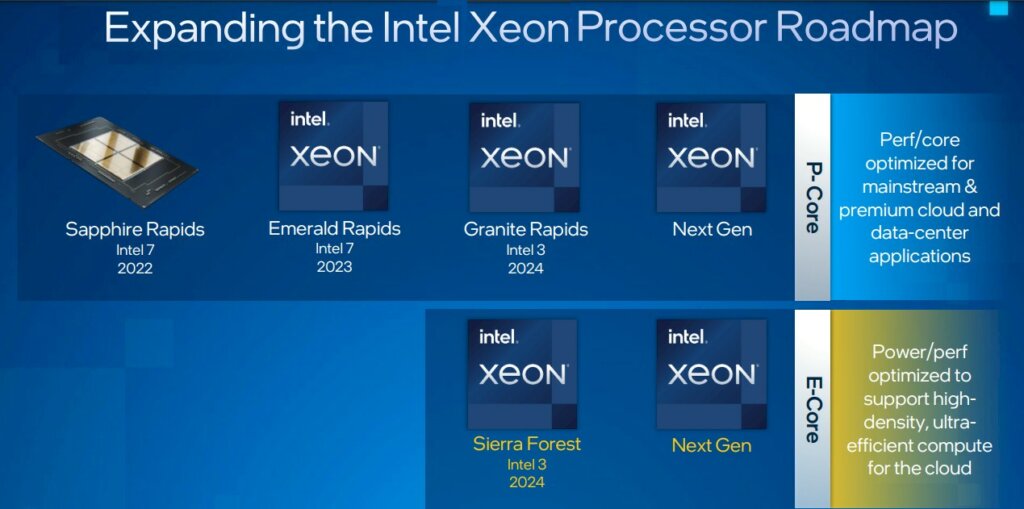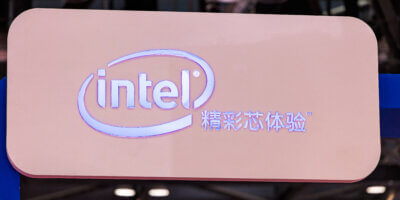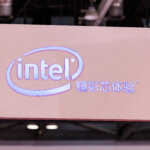
During the Hot Chips 2023, Intel teased its latest Xeon processors, Granite Rapids and Sierra Forest, which are set to launch in 2024. Source: Shutterstock
Intel: Everything we know about the upcoming Xeon processors
- During Hot Chips 2023, Intel teased its latest Xeon processors.
- The Granite Rapids and Sierra Forest chips are set to launch in 2024.
- Intel has hinted that its “Sierra Forest” chip will have 240% better performance per watt than its current generation of data center chips.
When Intel held its Data Center and AI Investor Webinar in March, the chip giant unveiled Sierra Forest, its first-gen E-core-based Xeon server processor. The latest processors will be the first semiconductors for data centers by Intel – and after long delays, the company confirmed that it will finally be made available by the first half of 2024.
For context, Intel’s data center and AI roadmap involves a lineup of two categories, P-Core & E-Core. The P-Core products will be the standard Xeon products we have seen over the years. The latest E-Core products on the other hand are the first energy-efficient architecture chips from Intel, with the first product being the Sierra Forest processors.
Intel is almost as infamous for its product delays as it is famous for its chip designs these days, yet it holds a significant market share of 71% in the PC and server processing chips sector, down from 90% in 2017.
“Intel remained the market leader with a 71% share, although far from the share it commanded until 2018. Its revenue from the segment dropped 16% YoY in 2022,” Counterpoint Research noted in a report.
The report’s analysts attributed the market share decline to delays in Intel delivering its latest processors and products, and weakness in enterprise spending due to macroeconomic conditions. However, Sandra Rivera, head of Intel’s Data Center and AI Group, who admitted the company’s recent struggles, affirmed that Intel is now on track, hitting key engineering milestones.
To put things into context, the fourth-generation Xeon processor, Sapphire Rapids, faced delays, allowing AMD to narrow the gap. Rivera confirmed that the fifth-generation Xeon processor, Emerald Rapids, will be delivered by the end of 2023. The next-generation Granite Rapids processor is set for a 2024 release, followed by Sierra Forest.
Clearwater Forest, another energy-efficient chip, is planned for a 2025 launch.

Intel multi-year Xeon roadmap to accelerate data center leadership and growth. Source: Intel
Counterpoint’s senior research analyst, Akshara Bassi, said “Even though Intel is still the market leader, its market share lost points to AMD’s rising product portfolio and better performance over Intel. AMD surpassed Intel in market share growth in 2022. Intel suffered due to continued delays in releasing its next-generation product, Sapphire Rapids, generationally comparable to AMD’s Milan, launched in 2021.”
Intel teased its latest Xeon processors at Hot Chips 2023
At the annual Hot Chips conference this week, many of the industry’s biggest chip design firms discussed their latest and upcoming products. Intel specifically took the stage to talk about its next generation of Xeon processors, Granite Rapids and Sierra Forest, which are set to launch next year.

At Intel’s 2022 investor meeting, the company provided the first view of its new Intel Xeon roadmap extending through 2024. Source: Intel
This is Intel’s first time splitting its data center chips into two categories – the “Granite Rapids” chip, which will focus on performance but consume more power, and the more efficient “Sierra Forest” chip. During the semiconductor technology conference at Stanford University, Intel said its “Sierra Forest” chip will have 240% better performance per watt than its current generation of data center chips.
It was the first time the company had disclosed such figures. The move by Intel is seen as a way to reassure the market that the company is still on track to deliver in early 2024, as promised. Lisa Spelman, Intel corporate vice president and general manager of Xeon Products and Solutions, said, “We recently shipped our millionth 4th Gen Xeon. Our 5th Gen Xeon (Emerald Rapids) will launch in Q4 2023, and our 2024 portfolio of data center products will prove to be a force in the industry.”
Based on the technical specifications revealed at Hot Chips, the new Sierra Forest and Granite Rapids processors will utilize modular system-on-chips (SoCs) for increased scalability and flexibility. This will enable a range of products that meet the growing scale, processing, and power efficiency needs for AI, cloud, and enterprise installations.

Intel is acknowledging the industry trend toward there being an entire market segment for cloud-native computing. Source: Intel
The architecture also offers two different socket-compatible processors, allowing for “simplicity and interchangeability for any workload,” Lisa noted. Intel’s E-core processors, Sierra Forest, are designed to deliver density-optimized computing power efficiently, boasting 2.5x better rack density and 2.4x higher performance per watt.
On the other hand, the P-core processors, Granite Rapids, are optimized to deliver the lowest total cost of ownership for high-core performance-sensitive workloads. They offer two to three times better performance for mixed AI workloads and come with built-in accelerators for targeted workloads.
After losing market share to AMD and Ampere Computing, a start-up founded by ex-Intel executives (and the first company to market with a chip focused on handling cloud computing work efficiently), Intel had to prove its point.
After Ampere introduced its chip, Intel and AMD followed suit by announcing similar products, with AMD’s offering hitting the market in June.
Whether the market allows Intel a full bounce-back will depend on what happens in 2024 – more delays, or a delivery that lets Intel prove its renaissance is more than words. But investors and the market as a whole are likely to be soothed by the announcement of the Intel Xeon roadmap.
READ MORE
- Enhancing Business Agility with SASE: Insights for CIOs in APAC
- 3 Steps to Successfully Automate Copilot for Microsoft 365 Implementation
- Trustworthy AI – the Promise of Enterprise-Friendly Generative Machine Learning with Dell and NVIDIA
- Strategies for Democratizing GenAI
- The criticality of endpoint management in cybersecurity and operations




